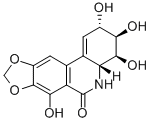Description:
Narciclasine, which can be found in the tubers of Narcissus tazetta, displays marked proapoptotic and cytotoxic activity, as does pancratistatin, and significant in vivo anticancer effects in various experimental models. It is a potential agent for the treatment of primary brain cancers and various brain metastases.
- Molecular Weight: 307.25
- Molecular Formula: C14H13NO7
Purity: ≥95%
Canonical SMILES:
C1OC2=C(O1)C(=C3C(=C2)C4=CC(C(C(C4NC3=O)O)O)O)O
InChI:
InChI=1S/C14H13NO7/c16-6-1-5-4-2-7-13(22-3-21-7)11(18)8(4)14(20)15-9(5)12(19)10(6)17/h1-2,6,9-10,12,16-19H,3H2,(H,15,20)/t6-,9+,10+,12-/m0/s1
InChIKey: LZAZURSABQIKGB-AEKGRLRDSA-N
- Boiling Point: 733.8±60.0 °C | Condition: Press: 760 Torr
- Melting Point: 246 °C (decomp)
- Solubility: Soluble to > 10 mg.mL in DMSO
- Appearance: Solid powder
- Application: Anti-inflammatory
- Storage: Store in a cool and dry place and at 0 - 4°C for short term (days to weeks) or -49°C for long term (months to years).
Synonyms:
(13β)-1,19-Didehydro-2α,3β,4β,7-tetrahydroxy-11,12-dinor-5,19-secocrinan-6-one; (2S)-3,4,4aβ,5-Tetrahydro-2α,3β,4β,7-tetrahydroxy[1,3]dioxolo[4,5-j]phenanthridin-6(2H)-one; Lycorcidinol
More details are to be found on supplier website
